Entries from September 2009
September 6th, 2009 · 1 Comment
No museum has affected me as viscerally as The Victoria and Albert Museum in South Kensington. Immediately upon entering the museum I was struck by the sight of life-sized Rodin sculptures of the human body that were raised above eye level, which created, for me, a sense of the insignificance of the appreciator, and likewise, the importance of art over all things. These sculptures were grotesque; Rodin used a technique that rendered them black and raw-looking, as if they had once been alive and thrown into a fire, then the charred remains removed and put on display. Though they were shocking and somewhat disturbing, Rodin’s pieces elicited in me a very emotional response, one that cut to the core of my perceptions of the self and of humanity, and one that I can neither explain nor recreate for the reader.
I also really enjoyed seeing several sculptures by Alfred Stevens, including a copy of the original “Truth and Falsehood” which is a part of The Wellington Memorial which we saw at St. Paul’s Cathedral several days ago.
The fashion and jewelry exhibits at the Victoria Albert were equally as touching, but for different reasons. Coming from a background in feminism, I was disappointed in those women who conformed to societal ideals of beauty – women who cinched their waists and bustled their butts, weighing themselves down with heavy jewelry, changing and shifting and molding themselves to ‘fit,’ quite literally, into the beauty myth. One display featuring a bustle and the wooden innards of a hoopskirt were reminiscent of a cage. And would it really be so far from the truth if it were?
Another exhibit which really hit me was photography. A great little exhibit, though I do wish it were larger. I thought that all of the works were quite good, though I connected on a deeper level with just two prints. The first piece was strikingly different. The artist worked with the principles of light and photography and used the sun to burn a simple design into the photo paper. I didn’t quite understand the process by which the piece was created but that’s the beauty of art, isn’t it? You don’t always have to understand it, or at least understand it as the artist does.
One piece that I definitely took a bit of “viewer’s license” to form my own interpretation was a photograph of a beautiful black model in a traditional Georgian dress and wig – both stark white. In her delicate hand she held a large diamond, perfectly cut and gleaming. Her head tilted towards the diamond in her hand, yet her eyes remained fixed intently on the camera. I thought that this piece, out of all the pieces of artwork I have seen at any exhibit thus far, had the most to say. It powerfully conveyed, by capturing just a single moment in time, hundreds of years of British imperialism and the pain it caused the imperialized. The Africans and West Indians were brought to perhaps not-so-‘Great’ Britain and taught that being ripped from their homelands like so many weeds was a privilege. They drowned the enslaved in western culture, which is represented by the model wearing the white (this was surely no mistake) Georgian garb, and meanwhile robbed their homelands of natural resources – such as diamonds and gold – for their own profit.
“Has imperialism, has slavery, really ended?” one must ask him or herself when one considers that there are still related issues in today’s society. The answer should become glaringly apparent when one considers Westerners’ continued thirst for diamonds. Though our presence in the diamond mines of Africa, in places like Sierra Leone, The Democratic Republic of Congo and Angola, may not be physical, our socially-sculpted ideologies surrounding the institution of marriage perpetuates these issues, and exacerbates the problems surrounding blood diamonds. So, for all you ladies out there: next time you stare doe-eyed into a Zales’ display window and exclaim in “I can’t wait to get married!” think twice about what societal forces and social constructions may be at work when you consider the “necessity” of an engagement ring. And the next time you look at a piece of art, everyone, look a little deeper and listen a little closer to what the piece may be trying to say.


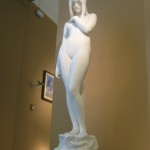



Tags: Anya · Museums
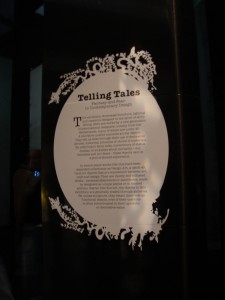
Outside the 'Telling Tales' exhibit
There were many things I adored about the V&A museum: the entrance way of marble Greek sculptures, the fashion wing including one of Princess Diana’s dresses. But what took my breath away the most was the fairy tale exhibit, Telling Tales. As many of you know, I have a childlike obsession with fairy tales and Disney movies, especially the Little Mermaid. But it is not the Disney story or the catchy songs that make me love these stories even as the years go by, but rather the way that these stories can transform a young child’s hopes and dreams into a story that suspends reality. These stories create a new world where children can hide for a little while. Who wouldn’t love that?
Well the Telling Tales exhibit at the V&A museum did just that: suspend reality and take the audience into a magical fantasy world. The works of art on display were amazing manifestations of the classical fairytales in furniture and sculpture. But that was not even the best part of the exhibit, rather it was the way that entire space was like a fairytale. Each room followed a different theme: the forest glade, the enchanted castle, and heaven and hell. To say that each of these rooms’ atmospheres matched their titles would be an understatement. When I entered the first room, the enchanted forest, all the walls and lighting matched that of a forest. It was likewise for each room. With this, the exhibit was able to achieve exactly what a fairytale is meant to: suspend reality.
The V&A museum mostly deals with exhibitions about design. Besides the suspension of reality, this show captures the elements of fairytales: dreams, hope, fear, beauty, and of course happy endings. Although the exhibit ended darkly with the heaven and hell room, I think in this way it remained grounded in realtiy. Afterall, we are not in a fairytale. And eventually the suspension of reality ends. And what better place to end it than with death, where everything ultimately ends?
Note: Photo slideshow of the V&A museum to come soon. However the Teling Tales Exhibit did not allow photography inside.
Tags: Megan · Museums
When people hear the word Oxford, they think of a very selective and highly demanding school. And it’s true; the University of Oxford is an elite institution. However, Oxford usually doesn’t conjure up images of the town itself. I will not deny that parts of the town were beautiful, but many parts were a bit too touristy. At certain points throughout Oxford I felt as if I was just walking through a series of strip malls. Such sights were not what I expected Oxford to look like at all; instead I thought I would be seeing just a picture perfect small college town.
On top of this, those “lucky” enough to have been with a certain tour guide are aware of how boring Oxford can be made to be. I know our tour guide had the best intentions, but the manner in which he toured us around Oxford made me want to fall asleep. If that is a glimpse of the Oxford experience, I’ll gladly take Dickinson.
That said, the colleges of Oxford are amazing. The architecture is beyond belief and to have the opportunity to study at one of the colleges would truly be a privilege. The dining hall we visited was extraordinary and surprisingly cheap to eat at (3 pounds for a meal if I remember correctly). Speaking of prices, I have to say that the price of tuition caught me off guard. To pay only 9,000+ pounds in order to attend this elite institution is something I am still trying to wrap my mind around. If only Dickinson would follow suit…
Something I found particularly interesting was how hostile the university was to the sciences. Having a completely separate science library so that it wouldn’t “infect” the classical studies of the students is fascinating. Though it does make sense now that I think about, I still believe that such an attitude shows just how far we have progressed; science is no longer seen as an enemy (at least by those who can actually think on their own).
In the end, the University of Oxford was truly an awesome experience. Though the tour guide was a bit boring, he still explained the history very well (and made us ponder the universe and infinity). I only wish the town of Oxford itself was less touristy and less ritzy.
Tags: Andrew F
September 6th, 2009 · 1 Comment
I have not had much experience with other religions besides various denominations of Christianity, so the recent visits to the Sikh and Hindu temples were eye-opening experiences for me. My lingering feelings and perceptions of the two are strikingly different, even though I associate the two closely in my mind. Because I don’t know much about Sikhism or Hinduism, their doctrines seem similar: live peacefully, teach future generations in a moral and religious way, and maintain a relationship with God. The services, though, spurred entirely different reactions for me.
I found the Sikh temple to be comfortable and enjoyable. I didn’t feel as though a lot was expected of members of their particular congregation (or me). So many religions spend so much time outlining and detailing every aspect of how to be a “successful” follower of that particular sect, but this one felt much more relaxed. More of a focus seemed to be put on finding a personal feeling of fulfillment rather than following specific doctrine or dogma. For example, even though I am not Catholic I do attend mass frequently and help lead a Catholic youth group. I know that part of being Catholic (for most parishes) involves carefully following a certain timeline: baptism as an infant, a CCD program during elementary/middle school, communion as a child, and so on. In contrast, our guide said that there is no specific time to be welcomed into the Sikh family; rather, a child may join the congregation when he feels that it is appropriate, whether as a child, teenager, or adult. I enjoyed the personal emotion and experience that our guide shared in the talk, and I think it was wonderful that his job is not specifically that of a tour guide because it made him that much more believable. Instead of a series of memorized facts, it felt much more individual and real.
That said, I felt a bit strange as a visitor in the temple. I completely support going for the sake of learning and reflecting, but if I was a member of the congregation, I think I would look at our group almost as if we were mocking them. Since they don’t normally do tours, I think having such a large group dressed in regular street clothes with scarves tossed on haphazardly outside the temple to cover our hair was borderline disrespectful. I feel that smaller groups would have been more effective, since we would not be making such a spectacle of ourselves.
Again, the following is simply my personal reaction and is not meant to offend: I found the Hindu temple creepy and bewildering. The most striking aspect, to me, was the ornate dolls (is there another term for them?) scattered throughout the temple. Given the nature of my religious upbringing, I looked at them as a form of idolatry. I don’t understand the significance of them, nor do I understand how anyone has the authority to “put the spirit of God” into them. I felt that the concept of one main guru to govern the entire Hindu population was strange and didn’t make sense. How does he objectively know who the next authority should be? If it is subjective, how can he be chosen by God? What if a detrimental ruler is chosen? How can people blindly trust one man when they do not know the logic behind his decisions? I’m sure his followers find reasons to unquestioningly follow his choices, but I’m not sure that I would be able to. Even a matter as small as the cost of the temple, shrouded as a secret, makes me uneasy.
Overall, I learned a lot but I think that my experience was certainly affected by my own religions upbringing and spiritual opinions. I hope to learn more about the aspects of each temple that I did not understand, and am glad I had the opportunity to glimpse the way that such a large portion of the world’s population worships God.
Tags: Amy
So arriving in London two weeks ago I have dove into a world of museums, churches, and recognizable landmarks (some of these locations encompassing all three of these aspects; ie. Westminster Abbey/St Paul’s ). As I read my other classmates blogs about these locations I was less than inspired though to throw my two-sense into the conversation. However after visiting the Sikh gurdwara I realized that discussing the architecture or the history of these churches was not what I was interested in. Rather, my focus was on the spirituality and religious nature of these locations (or lack there of as the case may be).
I’d be crazy not to acknowledge Westmnister Abbey’s incredible architecture– the dedication to style as additions were made to the building, the multitude of famous persons from his or her particular field buried in the ground of the building. I had the same reeling of awe walking around St. Paul’s Cathedral. The detailed stained glass windows, the enormous dome, the ceremonial burial sites all over the building—they are images I will remember forever. However, as I left both of those places I felt more like I was leaving a museum than a church.
Because of this feeling I decided to stay at St. Paul’s for evening song. It was a beautiful service, but I continuously found myself distracted by the other tourists walking up and down the church looking at all of the graves. I hoped that I would find myself in a state of spiritual prayer, but only found myself frustrated. I had a similar reaction when I sat in on Holy Communion at Bath Abbey. Sitting in another beautiful church, trying to take in and appreciate the holiest of sacraments and all I could focus on was the people going in and out of the attached gift shop.
While also in Bath I decided to wander down random alleys exploring the city. It was here where I ran into St. John the Evangelist, a Roman Catholic Church. Being the first Catholic church I had seen since arriving I decided to go in. Assuming to find myself surrounded by graves and gift shops yet again, I was in disbelief to find myself in one of the most beautiful churches I have ever seen. No gimmicks. No crowds. Beautiful architecture. Amazing stained glass. And peace. I couldn’t even tell you how long I just sat there, engulfed in the church’s beauty and feeling of spirituality.
When I attended St. Patrick’s in SOHO for a service I hoped I would feel the same sense of peace I did in Bath, but was slightly disappointed not to. I’m not sure why, but I’m hoping as I continue to investigate churches in both London and Norwich I will find a common thread in why I find some churches and temples more spiritual than others.
**I wrote this last night, and I thought it had posted. And now after visiting the Hindu temple I have even more thoughts on this subject, but will expand later. **
Tags: Amanda · Churches and Cathedrals
I believe Brandon and I have won the award for worst bird poop incident. Not only did we have bird poop on us the entire day, it was like freaking Niagara Falls bird poop, splattered everywhere….. and my sweater is dry clean only.. stupid bird.
When I first sat down to write this post, I thought my views on identity were simple. Simple meaning; you are who you are, don’t throw a fit, its easy, kind of simple. After I realized I had virtually nothing to write about, I figured I needed more time to allow myself to further my knowledge on what identity is.
This time around, after viewing what I though may help my argument, (the Sikh and Hindu Temples), I have gained some understanding of what identity is. It is apparent that, the search for and loss of identity reflects entire generations in the city of London. The book Salam Brick Lane is a perfect example of the diverse population attempting to search for a British identity while also trying to grasp their own at the same time.
It seems as though Londoners want immigrants to assimilate into their culture. Does this mean, then that once a man from India, of darker complexion, who works in the city, goes to fun pubs at night, and lives in an upscale neighborhood, in other words “assimilated”, can only identify now with British culture? For that matter, if one does do these things, is he/she unable to identify with their original culture?
The two temples we saw represent how immigrant populations have migrated to an area where they can openly worship a religion brought from another country. In these temples we saw people who practice a very strict form of both Hinduism and Sikhism but we also saw those who dare to use the term, “more westernized”. We see these people worshiping in street clothing and we know it is their choice, but how do they feel? Do they feel trapped within one culture, or do they feel as though they want both?
I guess what I am trying to argue is that identity can not be defined by another person. As a matter of fact, identity can just as easily never be defined. It is ones choice to have an identity and it is also their choice to not. The real issue involves the ways in which a country handles an immigrant populations decision to choose their identities meaning, they have to allow each individual to make the decision.
I am an America. I descend from Germany, Ireland, Scotland, and England, but me, myself, and I, am an America. But, if I ever choose to move to England or another country, I would hope that my identity would be at liberty to alternation based on who I want to be and who I choose to identify with.
Tags: Patsy

“You’re sacred space is where you can find yourself over and over again.” (Joseph Campell)
The concept of space, so immense, so undefined. As intriguing as one may be with the notion of sacred spaces, either physical or internal, it is difficult to grasp the full idea of what it means to feel a part of a specific space, to immerse oneself in it.
As we entered the Gudwara, internally, I had just opened the door to a room of confusion, although physically I was right where I was supposed to be. The ability to learn extensively in moments of discomfort is something I attempt to take advantage of, but for some reason I was unable to keep an open mind. Throughout our tour, I felt a sense of indifference, not just because I am not a religious individual in any way, but also because I like to keep myself at a distance from spaces that with hold religious power over a community. Surprisingly, my experience at St.Paul’s was not in any way similar to the Gudwara’s. At St.Pauls’ I felt as if I was entering a museum, a sacred place of historical exhibition instead of worship. In comparison to Westminster Abbey, St.Pauls’ was less scary (maybe because there aren’t 3000 bodies buried there). I think tourism has completely changed the dynamic of these sacred spaces, converting them into exhibits for the general public.
So what differs a museum from a place of worship? In London, I think museums as well as churches are both worshipped in their own ways. We have visited multiple museums and various churches in our time in London, where I have realized that it takes more than just a space to create a place of worship, it takes the masses, the worshippers, to raise a space to a state of “holy-ness.” When we have class at the Victoria Gardens at Regents Park, the patch of grass surrounding us, the space chosen for our discussions is our sacred space for that moment; when we enter it, we become a part of it, not just literally but also metaphorically.
When we entered the Gudwara, most of us were encountered with unknown territory, strange feelings awakened. Although, this space was not at all a tourist attraction, our presence in that place made it feel like another museum exhibit, like something to study, observe and take notes on for future reference… not a place of sacred worshiping. Isn’t it interesting how this concept of space dominates our everyday lives, yet it is so undefined.
Indefinitely, whatever you’re sacred space is, make it yours. Personalize it, love it, breath it, worship it… define it for yourself, in the hopes that you’ll continue to find yourself in that place over and over again.
Tags: Flow

So this is an overdue post comparing our experiences at the National Gallery and the Tate Modern.
When we were climbing the steps of the National Gallery we were anticipating the beautiful pieces that would be displayed by world renowned artists. We were excited to see the works of Van Gogh, Da Vinci, Van Dyck as well as artists who are unfamiliar to us. While standing in front of Da Vinci’s Madonna and Child, observing his rather passionate and intricate work we felt a disconnect between our previous assumptions of how the work was suppose to affect us versus our actual interpretations. Based on our shared knowledge of these artistic “masterpieces” we hoped to feel the sense of awe. Although we were privileged to be viewing these works, we left feeling rather “eghhh” (for lack of a better term).
Our experience at the Tate Modern JUXTAPOSED our feelings of incomplete satisfaction at the National Gallery. We were immediately intrigued by the modern and uncommon artistic works. These revolutionized pieces made us question the true meaning of art. IN our interpretation of the works found at Tate, modern art in Britain completely attempts to move away from traditional, classical art found at the National Gallery. Although we do appreciate classical art, modern art speaks to us in a different form, and it relates to the ways in which we seek to see the rest of our society— in distinctive ways. The Tate Modern seems to be “pushing the envelope” when it comes to artistic expressions and we enjoy that sort of rebellious attitude.
Overall, art is an interpretation of the individual and it can exist in various forms. It is always inspired and interpreted.
Tags: Anthony · Flow · Jeyla
On Wednesday September 2nd, 2009 the Norwich Humanities group visited the East End, in particular, Brick Lane, and the surrounding area. Brick Lane’s history over the past 15 years had changed drastically. It has gone from a neighborhood of violence, drugs, and trash, to a respectable neighborhood. This area has seen drastic progress in this fifteen year period, but progress at the expense of who?
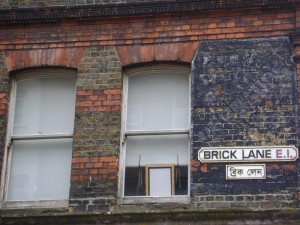 People always view progress as a positive thing, because, it means improvement for a community that means it. What I have learned being in London, is that progress has the potential to be something great, but at the expense of who? Professor Qualls has made me realize these past few days, is that the concept of progress is something beneficial, to a specific group, but at the expense of who? In order for true progress to be made a specific group must pay. Looking at the east end, it is obvious that the area is becoming economically improved, but at the expense of the middle and working classes in the area. The area is beginning to see major improvements, in both the markets and financial district, but the lower classes are taking a beating, because soon they will not be able to afford the area in which they live, and will be forced to move out. In essence this is progress in its truest form. However, it felt surreal to be in an area in which we have read so much about, and viewing the drastic changes in the area, gave me a sense of joy, but this emotion was balanced with a sense of sadness because of the effects this had on the community.
People always view progress as a positive thing, because, it means improvement for a community that means it. What I have learned being in London, is that progress has the potential to be something great, but at the expense of who? Professor Qualls has made me realize these past few days, is that the concept of progress is something beneficial, to a specific group, but at the expense of who? In order for true progress to be made a specific group must pay. Looking at the east end, it is obvious that the area is becoming economically improved, but at the expense of the middle and working classes in the area. The area is beginning to see major improvements, in both the markets and financial district, but the lower classes are taking a beating, because soon they will not be able to afford the area in which they live, and will be forced to move out. In essence this is progress in its truest form. However, it felt surreal to be in an area in which we have read so much about, and viewing the drastic changes in the area, gave me a sense of joy, but this emotion was balanced with a sense of sadness because of the effects this had on the community.
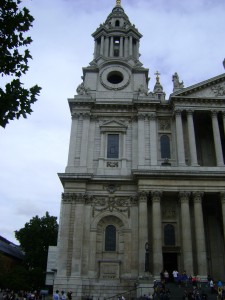 We later travelled to St. Pauls’ lead by our fabulous tour guide John. John was our tour guide for the West Minster Abbey, and because he did such an amazing job, professor Qualls decided John was more than capable to lead us in this national land mark of London. Once we all had arrived John began speaking about the birth of the St. Pauls’ Cathedral and the route and the history of its name. One thing Jon said before entering that I didn’t agree with was when he said, “be mindful that this place is still a church so please be mindful.” Once I entered St. Paul’s cathedral, I immediately noticed the outrageous fee to enter this “church.” I could not help but see this ever apparent contradiction, in that museum cost money, and churches are supposed to be free. Not only that but the electronic tour guides, and the amount of people who just seemed interested in looking at its architecture rather than praising god could have not convinced me more, that this Cathedral had lost its “holiness” a long time ago, at least in my opinion. My perceptions of St. Paul as a tourist attraction, however, were nothing but positive. The architecture was beautiful, and its history was astounding. As I climbed the steps of St. Pauls’ I could not help but think that in the immediate future I would be on the top of the city.
We later travelled to St. Pauls’ lead by our fabulous tour guide John. John was our tour guide for the West Minster Abbey, and because he did such an amazing job, professor Qualls decided John was more than capable to lead us in this national land mark of London. Once we all had arrived John began speaking about the birth of the St. Pauls’ Cathedral and the route and the history of its name. One thing Jon said before entering that I didn’t agree with was when he said, “be mindful that this place is still a church so please be mindful.” Once I entered St. Paul’s cathedral, I immediately noticed the outrageous fee to enter this “church.” I could not help but see this ever apparent contradiction, in that museum cost money, and churches are supposed to be free. Not only that but the electronic tour guides, and the amount of people who just seemed interested in looking at its architecture rather than praising god could have not convinced me more, that this Cathedral had lost its “holiness” a long time ago, at least in my opinion. My perceptions of St. Paul as a tourist attraction, however, were nothing but positive. The architecture was beautiful, and its history was astounding. As I climbed the steps of St. Pauls’ I could not help but think that in the immediate future I would be on the top of the city.
 Once I arrived the scenery was amazingly beautiful, I had never seen such an astounding sight. I was able to view London from an entirely different vantage point, and in doing so, I realized the true beauty of this chaotic city. I realized that, London, was the only city I have ever been to that had such an interesting personality, from the people, to its appearance, its multifaceted diversity was something that out of a book. It was something I will not soon forget!!!
Once I arrived the scenery was amazingly beautiful, I had never seen such an astounding sight. I was able to view London from an entirely different vantage point, and in doing so, I realized the true beauty of this chaotic city. I realized that, London, was the only city I have ever been to that had such an interesting personality, from the people, to its appearance, its multifaceted diversity was something that out of a book. It was something I will not soon forget!!!
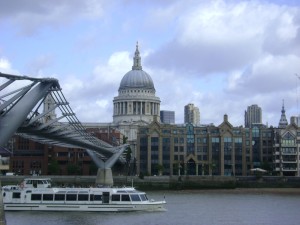
Tags: Anthony
September 5th, 2009 · 1 Comment
A great perk about studying abroad in England is that you’re doing just that: studying. Everything we do is a learning opportunity. We constantly are taking note of the interactions between people, what groups of people are present in what area, and conversely what groups of people are absent from what areas. As much as I love this constant state of observation, I can’t help but wonder if sometimes I’m reading too much into situations. About three minutes ago when I started this blog, I planned to write on how different groups of people are treated differently throughout London. I still believe this is true. But in those three minutes, a wonderful thing happened. Space Jam came on! If you don’t remember, the movie involves Michael Jordan and Bugs Bunny saving the world from evil aliens. Talk about quality entertainment! Two children from London picked out the flick to watch before their bedtime and, being the mature people that we are, four of my fellow students and I are kindly decided to keep them company (while reciting our favorite lines right along with them). The children can’t be more than nine years old. We are all a little more than double their ages. Yet here we are all sitting around a television enjoying a Saturday night together. As this happens, I’m wondering: just how differently are separate groups of people in London? In its first couple scenes, Space Jam has told us that forced control over others is wrong, that stealing talents and goods from others is wrong, that everyone has something to learn from others, and that everyone has something to teach others- not too shabby for a movie that stars a basketball player and an animated rabbit. On our visit to a gurdwara, we were told that those who followed Sikhism believed in lifelong communal learning as well. I in no way mean to belittle Sikhism to the level of Space Jam. I do believe though that the people sitting in the lounge with me are listening to similar messages as those that are delivered in gurdwaras. With such similarities being apparent in mainstream culture and arguably a minority religious belief in London, the separation between these groups is sadly easy to recognize. This may seem paradoxical but I believe it makes sense. Clearly, the mainstream culture and minority cultures claim to believe in similar ideals: communal learning. Yet the London community is separated (making such learning difficult) based off of ethnicity, race, and class. How frustrating! I could understand if these groups’ core values or ideals were so conflicting that problems arose and, therefore, separation made a bit more sense. But that doesn’t seem to be the case. Some sort of disconnect is present. A misunderstanding between cultures? A hypocrisy in one or both? What accounts for this separation?
There doesn’t seem to be easy answer. Our class discussions have tended to point the finger at the majority culture and for the most point I’ve supported that sentiment. But I don’t know if the answer is really that simple; that is, I don’t think that the mainstream culture holds 100% of the responsibility for the separation that exists between cultures. But Space Jam reminds us that we can all get along in the end if we just communicate with one another instead of ignoring how much we have in common and highlighting our differences. That’s not to say that our differences should be completely erased. The Sikhs have a beautifully unique lifestyle that, in my opinion, shouldn’t be ‘mainstreamed’. But to have a gurdwara all the way in Southall rather than have a felt presence in London, to have Brick Lane be a predominantly Bengali community with few other places in the city where such communities exist, basically to have a separated society is, to me, exactly opposite of what all of these communities teach. Maybe Michael and Bugs need to make another movie for this lesson to be learned. I know I would gladly spend another Saturday night learning from them. But my hope is that the lesson isn’t just taught. Clearly, that is already happening. The hope is that the lesson starts being learned and applied. Maybe I’m reading too much into Space Jam’s influence on London culture. But as a student who is always observing and studying what’s going on in my surroundings, I don’t entirely think that’s the case.
Tags: Audrey












 People always view progress as a positive thing, because, it means improvement for a community that means it. What I have learned being in London, is that progress has the potential to be something great, but at the expense of who? Professor Qualls has made me realize these past few days, is that the concept of progress is something beneficial, to a specific group, but at the expense of who? In order for true progress to be made a specific group must pay. Looking at the east end, it is obvious that the area is becoming economically improved, but at the expense of the middle and working classes in the area. The area is beginning to see major improvements, in both the markets and financial district, but the lower classes are taking a beating, because soon they will not be able to afford the area in which they live, and will be forced to move out. In essence this is progress in its truest form. However, it felt surreal to be in an area in which we have read so much about, and viewing the drastic changes in the area, gave me a sense of joy, but this emotion was balanced with a sense of sadness because of the effects this had on the community.
People always view progress as a positive thing, because, it means improvement for a community that means it. What I have learned being in London, is that progress has the potential to be something great, but at the expense of who? Professor Qualls has made me realize these past few days, is that the concept of progress is something beneficial, to a specific group, but at the expense of who? In order for true progress to be made a specific group must pay. Looking at the east end, it is obvious that the area is becoming economically improved, but at the expense of the middle and working classes in the area. The area is beginning to see major improvements, in both the markets and financial district, but the lower classes are taking a beating, because soon they will not be able to afford the area in which they live, and will be forced to move out. In essence this is progress in its truest form. However, it felt surreal to be in an area in which we have read so much about, and viewing the drastic changes in the area, gave me a sense of joy, but this emotion was balanced with a sense of sadness because of the effects this had on the community. We later travelled to St. Pauls’ lead by our fabulous tour guide John. John was our tour guide for the West Minster Abbey, and because he did such an amazing job, professor Qualls decided John was more than capable to lead us in this national land mark of London. Once we all had arrived John began speaking about the birth of the St. Pauls’ Cathedral and the route and the history of its name. One thing Jon said before entering that I didn’t agree with was when he said, “be mindful that this place is still a church so please be mindful.” Once I entered St. Paul’s cathedral, I immediately noticed the outrageous fee to enter this “church.” I could not help but see this ever apparent contradiction, in that museum cost money, and churches are supposed to be free. Not only that but the electronic tour guides, and the amount of people who just seemed interested in looking at its architecture rather than praising god could have not convinced me more, that this Cathedral had lost its “holiness” a long time ago, at least in my opinion. My perceptions of St. Paul as a tourist attraction, however, were nothing but positive. The architecture was beautiful, and its history was astounding. As I climbed the steps of St. Pauls’ I could not help but think that in the immediate future I would be on the top of the city.
We later travelled to St. Pauls’ lead by our fabulous tour guide John. John was our tour guide for the West Minster Abbey, and because he did such an amazing job, professor Qualls decided John was more than capable to lead us in this national land mark of London. Once we all had arrived John began speaking about the birth of the St. Pauls’ Cathedral and the route and the history of its name. One thing Jon said before entering that I didn’t agree with was when he said, “be mindful that this place is still a church so please be mindful.” Once I entered St. Paul’s cathedral, I immediately noticed the outrageous fee to enter this “church.” I could not help but see this ever apparent contradiction, in that museum cost money, and churches are supposed to be free. Not only that but the electronic tour guides, and the amount of people who just seemed interested in looking at its architecture rather than praising god could have not convinced me more, that this Cathedral had lost its “holiness” a long time ago, at least in my opinion. My perceptions of St. Paul as a tourist attraction, however, were nothing but positive. The architecture was beautiful, and its history was astounding. As I climbed the steps of St. Pauls’ I could not help but think that in the immediate future I would be on the top of the city. Once I arrived the scenery was amazingly beautiful, I had never seen such an astounding sight. I was able to view London from an entirely different vantage point, and in doing so, I realized the true beauty of this chaotic city. I realized that, London, was the only city I have ever been to that had such an interesting personality, from the people, to its appearance, its multifaceted diversity was something that out of a book. It was something I will not soon forget!!!
Once I arrived the scenery was amazingly beautiful, I had never seen such an astounding sight. I was able to view London from an entirely different vantage point, and in doing so, I realized the true beauty of this chaotic city. I realized that, London, was the only city I have ever been to that had such an interesting personality, from the people, to its appearance, its multifaceted diversity was something that out of a book. It was something I will not soon forget!!!